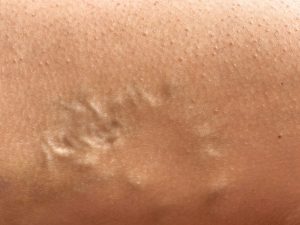Search a topic
Last updated on April 22, 2024
Spider veins vs varicose veins: what’s the difference? These are two types of damaged blood vessels. The former affects venules and capillaries near the skin’s surface, and the latter affects deeper veins. But while they share a few similarities, the conditions have notable differences. So, here’s how to tell them apart and what to do if you develop them.
What causes them?
Both spider and varicose veins are caused by increased pressure in the vein. In varicose veins, it’s often due to faulty valves. These valves work with the surrounding muscles to keep blood moving in the right direction. When the valves fail, the blood slips backwards and begins to pool, expanding the vein walls. Over time, this can result in the bulging, twisted veins.
Spider veins can also be the result of faulty valves. They can also develop from sudden and excessive pressure in the vein (such as from childbirth or weightlifting). And because they are so close to the surface of the skin, they may form due to sun damage.
Common risk factors for spider veins and varicose veins include:
- Genetics: if vein disorders run in your family, you’re unfortunately susceptible to them, too
- Pregnancy: hormones, increased blood volume, and increased pressure on the leg and abdominal veins create a perfect storm for vein issues
- Age: as we get older, the veins undergo natural wear and tear that weakens the walls and valves
- Sedentary lifestyle: Long hours of sitting or standing put pressure on the veins as the muscles aren’t moving to push blood up. Not getting enough exercise means weaker muscles and an increased risk of cardiovascular issues.
How to tell the difference between spider veins and varicose veins
Spider Veins
These are small threadlike or weblike veins appearing close to the skin’s surface. They are typically red or dark blue, and most often appear on the legs and face. Typically, spider veins won’t cause any symptoms.
Varicose Veins
These are large, twisted veins located deeper under the skin. They’ll bulge above the skin and appear green or blue. Varicose veins also often come with symptoms of pain, itching, and swelling.
How to prevent them
Spider veins and varicose veins aren’t 100% preventable, but there are steps you can take to minimise your risk of developing them.
- Make sure you get enough exercise. WHO recommends being active every day, with at least 150 minutes of moderate to high-intensity activity. For the health of your leg veins, walk 30 minutes a day and mix in some swimming, strengthening exercises, and yoga to keep your leg muscles toned, strong, and relaxed.
- Elevate your legs after a long day. Prop your feet above heart level for 15-30 minutes, especially if you’ve had a day full of sitting or standing. Elevating the legs reduces the strain on the veins and helps them move blood in the right direction. It also helps any pooled blood move toward the heart.
- Eat right. A diet rich in fruits, vegetables, and fibre will ensure your veins have all the nutrients and support they need to stay healthy.
- Wear compression. Compression socks stimulate the muscles and boost blood flow, making them a great addition to your wardrobe if you have a sedentary job or fly a lot.
Spider veins vs varicose veins treatment
If you do get spider or varicose veins, there are ways to treat them!
Varicose vein treatment options
- EVLA, or endovenous laser ablation
- RFA, or radiofrequency ablation
- Sclerotherapy (for smaller varicose veins)
- ClariVein
- Medical Superglue
If you’d like to learn more about these treatments or book a consultation to treat your varicose veins, head to our sister company, The Vein Institute.
Varicose veins can also be removed through surgical procedures like ambulatory phlebectomy or vein stripping.
Spider vein treatment options
- Sclerotherapy
- Nd:YAG, a transdermal (topical) laser
- CLaCS, a combination of the above two treatments
- Closure system therapy
- Thermocoagulation
These treatments are minimally to non-invasive. They seal the vein so blood stops flowing through it, prompting the body to absorb the vessel over time.
If you’d like to be rid of your spider veins, book a consultation with us today! Just fill out the form below to request an appointment or give us a call at 0483948908.







